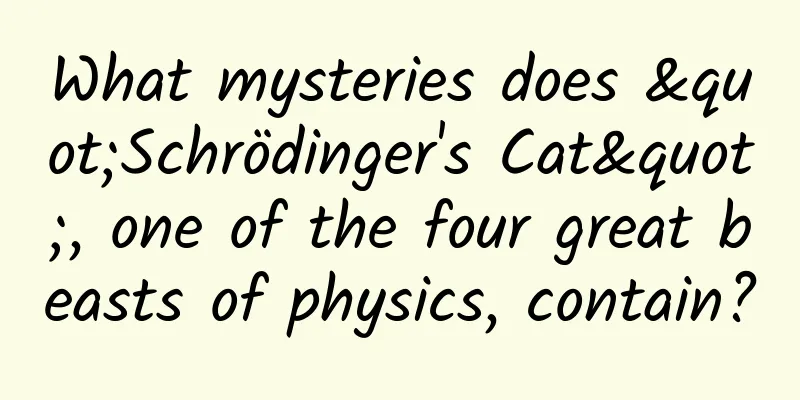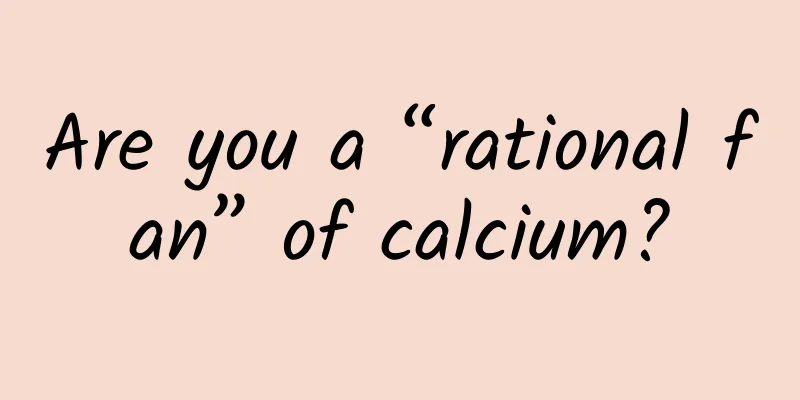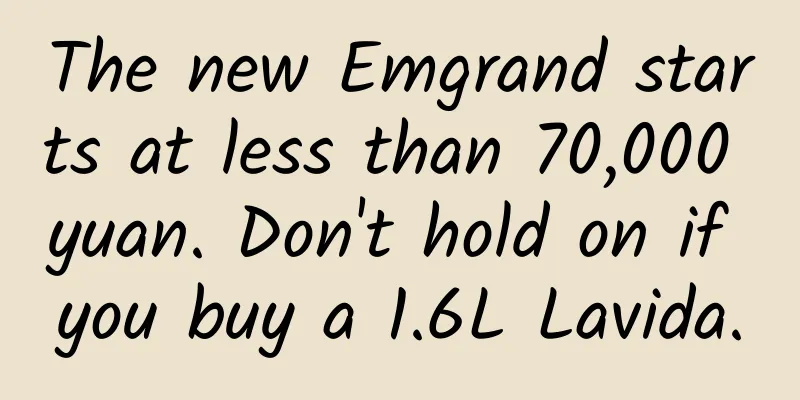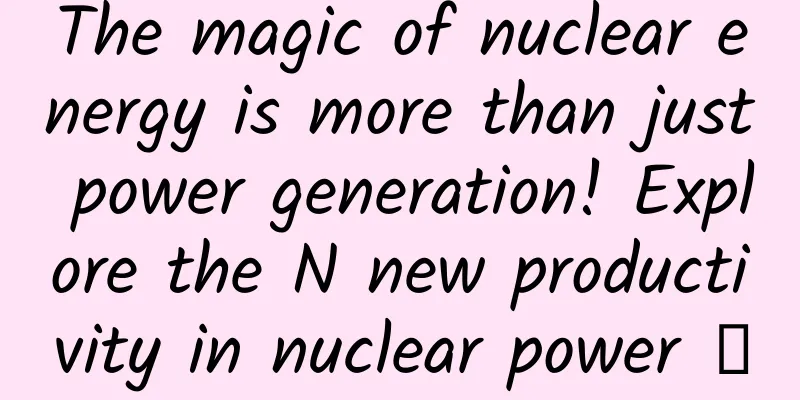What mysteries does "Schrödinger's Cat", one of the four great beasts of physics, contain?

|
Produced by: Science Popularization China Author: Luan Chunyang (Department of Physics, Tsinghua University) Producer: China Science Expo Some people are fascinated by the wonderful phenomena in quantum mechanics and hope to get a glimpse of the mysteries of the quantum world; some people regard quantum mechanics as a mystery and become confused when they hear various complex concepts. So, what exactly is quantum mechanics? In fact, quantum mechanics is not that mysterious. It has developed into a mature branch of physics. As early as the end of the 19th century, with the continuous exploration of the microscopic world, physicists gradually realized that the classical physics theory applicable to the macroscopic world could not explain the operating laws and some wonderful phenomena in the microscopic world. Therefore, after the unremitting efforts of physicists, they finally found a physical theory to describe the microscopic world, which is "quantum mechanics". It is precisely because the microscopic world described by quantum mechanics is different from the macroscopic world we live in that we are always accustomed to using classical physics theories to think about problems, and it is difficult to understand quantum mechanics. However, to grasp the essence of quantum mechanics, we only need to understand the core concept of "quantum entanglement". Quantum entanglement - the core concept of quantum mechanics theory I guess many of you have heard of quantum entanglement, but perhaps you don’t have a deep understanding of it. In the theoretical system of quantum mechanics, when several microscopic particles interact with each other, no matter how far apart they are, the physical quantities of these microscopic particles can only be described as a whole, and the physical quantities of a single microscopic particle can no longer be described separately. This phenomenon, which only exists in the microscopic world and describes the physical quantities of the entire system, is called "quantum entanglement." Here we give an example to more intuitively experience the wonders of quantum entanglement. For example, physicists can collide a positron and an electron, causing annihilation and releasing a pair of photons (you don’t have to worry about the concept of positrons and electrons, you just need to understand that the overall physical quantity of the pair of photons must be conserved). Since the total physical quantity of the pair of photons is always conserved, no matter how far apart the two photons are, a change in one photon will immediately cause a change in the other photon. Therefore, no matter how far apart the pair of photons are, they are always in a state of "quantum entanglement". Schematic diagram of quantum entanglement (Photo source: VEER Gallery) This phenomenon of quantum entanglement is incredible. This is because, if the pair of photons want to maintain this wonderful interaction, it means that they need to complete the signal transmission between each other in an instant. This instant superluminal interaction violates our common sense in the macroscopic world, so it is difficult to understand for a while. In fact, it is not only us who cannot understand quantum entanglement, but also many physicists find it difficult to explain this wonderful microscopic phenomenon. So even Einstein lamented that quantum entanglement is a kind of "ghostly interaction". Since the end of the 19th century, countless physicists have gradually uncovered the mystery of quantum entanglement through repeated collisions of ideas. It is also during the long-term debate that people gradually discovered the laws of operation in the microscopic world and further enriched and improved the theoretical system of quantum mechanics. So, how can we, as ordinary people, find the secrets of quantum mechanics in the wonderful and complex microscopic world? Let's follow the author and travel through time and space for a hundred years to experience the peak duels between the masters of physics on quantum entanglement! Classical Physics vs Quantum Physics From the late 19th century to the early 20th century, two major schools of thought emerged in the physics community at that time, which have had an impact to this day. One was the "classical physics school" represented by Einstein and Schrödinger, and the other was the "quantum physics school" represented by Bohr and Heisenberg. Einstein cartoon (Photo source: VEER Gallery) As the name implies, the classical physics school always insists on starting from the perspective of classical physics theory and thinking about physical problems with the experience of the macroscopic world. For example, Einstein has always emphasized that the physical world we live in should be "deterministic" rather than full of random probabilities. In addition, a complete physical theory should also follow strict "reality" and "locality". The above-mentioned "certainty" can be simply understood as follows: when we know all the physical information of the shaking dice (such as mass, speed, etc.), we can calculate the number of points on the dice through the laws of physics. In other words, rolling the dice itself is not a probabilistic event, but we do not know the result of rolling the dice because we do not know enough physical information. "Reality" means that the properties of the physical world are real in themselves, rather than dependent on our observation. Just like the moon will always be there, whether we look up at the night sky or not. The final "locality" means that there is interaction between objects, but the transmission speed of this interaction cannot exceed the speed of light, let alone be instantaneous. This is because Einstein's special theory of relativity tells us that the speed of light is the fastest speed in the universe. Niels Bohr (Image source: Wikipedia) However, the quantum physics school represented by Bohr and Heisenberg does not think so. In response to the certainty proposed by the classical physics school, the quantum physics school emphasizes that the microscopic world should follow the probabilistic nature in a statistical sense, and no longer always correspond to certain results like the macroscopic world. Therefore, the microscopic world is essentially "probabilistic". The *“probability” here means that in the microscopic world, the state of matter is uncertain. It may be like this or like that. There is a certain probability that it is like this or like that. In order to further describe the probabilistic events in the microscopic world, the quantum physics school proposed the concept of "wave function" to reflect this probabilistic nature. That is to say, the physical state in the microscopic world is always in a superposition of different states before being observed, and once it is observed, it will transform into a certain state. The "superposition" here is also a phenomenon unique to the microscopic world. For example, the decay of a single radioactive particle in the microscopic world is a probabilistic event. Therefore, within a period of time, a single radioactive particle has a certain probability of decaying and a certain probability of remaining the same. Then the radioactive ion is in a superposition state of "decayed/not decayed". As for the view held by the classical physics school that a complete physical theory should follow strict reality and locality, the quantum physics school also responded that this so-called reality and locality is only our understanding of the laws of operation of the macroscopic world, and is not applicable to the microscopic world. Therefore, we should use the concept of "quantum entanglement" in quantum mechanics to understand and deal with problems in the microscopic world. Quantum entanglement (Photo source: VEER Gallery) It can be said that the debate between classical physics and quantum physics about the microscopic world has gone beyond the scope of pure physics, and reflects the philosophical thinking of two cognitive worlds. Although Einstein was also one of the proposers of quantum mechanics, he always doubted the completeness of quantum mechanics and constantly proposed more profound thought experiments (using only logical reasoning without conducting corresponding experiments) to find loopholes in quantum mechanics. It is precisely because of this that the study of quantum mechanics has achieved unprecedented development and has prompted people to begin to think more deeply about the way to understand the world. In addition, experimental physicists have also verified the correctness of quantum mechanics with precise experimental results time and time again. In this ultimate showdown of academic views on physics, the two schools of thought refused to give in. Let's take a look at what happened next. "Schrödinger's Cat": I speak for quantum superposition The views of the classical school of physics have been supported by a large number of physicists, one of whom is the famous Schrödinger! In order to support the classical school of physics, Schrödinger conceived an interesting thought experiment, the "Schrödinger's cat" thought experiment, to refute the probabilistic view of the quantum physics school. "Schrödinger's cat" thought experiment (Photo source: VEER Gallery) In simple terms, Schrödinger assumed that a cat was placed in a completely sealed box, the internal state of which could not be detected by the outside world. There was also radioactive material inside the box that could decay probabilistically, as well as a gas release device to detect radioactive decay. If the radioactive material does not decay within a period of time, the poison gas release device will not be triggered, and the cat will still survive; however, if the radioactive material decays, the device will detect the decay event, thereby triggering the switch for poison gas release, and the poor cat will die. That is to say, before the box is opened, the cat's life or death depends on whether the radioactive material decays. However, something strange happened! According to quantum mechanics, in the microscopic world, whether the radioactive material decays or not is a probabilistic event and cannot be accurately predicted. Therefore, we can be surprised to find that before being observed, the cat cannot be in a certain state, but can only be said to be in a probabilistic superposition state of life/death! Schrödinger hoped to amplify the "probability" in the microscopic world believed by the quantum physics school to the macroscopic world, in order to violate the common sense in people's lives and thus reflect the absurdity of quantum theory. According to the macroscopic world we live in, Schrödinger's hypothesis is of course correct, and this probabilistic event is extremely absurd. Even Einstein lamented: "I don't believe that the moon in the night sky may disappear just because I didn't go to see it." Bohr's rebuttal: Abandon the ideas of the classical era and embrace the quantum era Schrödinger's thought experiment seems so perfect, but the quantum physics school does not recognize Schrödinger's thought experiment. Bohr believes that the classical physics school has not really realized the probabilistic nature of the microscopic world, but still uses the thinking of classical physics theory to apply the framework of quantum physics theory. The connection between the microscopic quantum world and our macroscopic world (Photo source: VEER Gallery) First of all, the probabilistic characteristics in the microscopic world should not correspond to specific things in the macroscopic world, but there should be a failure boundary . In other words, the microscopic event of "random decay of radioactive substances" in Schrödinger's thought experiment cannot be infinitely extended to the macroscopic world we live in. Therefore, we cannot describe the cat in the box using the probability of quantum mechanics, and there is no cat in a superposition state of life/death. Secondly, the "poison gas release device" in Schrödinger's thought experiment needs to detect the decay of radioactive material before it can be triggered and cause the death of the cat. However, this detection process must be a statistical process of a large number of radioactive materials decaying . In other words, the radiation emitted by a single decay process is too low to be effectively detected by the detector. Only when a large number of radioactive materials decay can it exceed the minimum threshold of the detector. Therefore, the process of this large number of decay events is still a macroscopic event in the statistical sense, rather than a microscopic event described by quantum theory. Finally, the detector detects whether the radioactive material decays, and this event itself is a form of observation. In other words, although we did not open the box to observe the internal state, the event of whether decay occurred or not was actually determined the moment the poison gas device was triggered. Therefore, the subsequent state of the cat is just a natural continuation of events, and there is no so-called superposition state of survival/death. Therefore, the quantum physics school keenly discovered the loopholes in "Schrödinger's cat" and used the concept of wave function in quantum mechanics to further consolidate its own views. Conclusion Although the classical physics school did not have an advantage in the first quantum showdown, and the "Schrödinger's cat" thought experiment, which was originally intended to refute quantum theory, accidentally became an interesting story to promote "quantum entanglement"*. However, the classical school of physics still insists on the view that "physics must be real, and physical laws must be strictly causal and objective." Therefore, Einstein was not willing to accept defeat. He was selecting suitable teammates from the masters of the classical school and preparing to launch a second quantum peak showdown against the quantum school where Bohr was. |
<<: Is there a person hidden in every ATM? Is this legendary "banking top secret" true?
Recommend
Looking at the decline of Japan's television industry, can China become the next South Korea?
China has always had an awkward position in the g...
Danger! Another person almost lost his face! Huaxi doctors remind you: Don’t take photos of this kind of insects
Although it is already autumn But the weather is ...
ViaPlay F2 game controller review: a game controller that beats touch screens
Hello guys~ Today we The packaging is very straig...
Apple has sent out invitations to its new product launch event in October 2014. It’s been a long time since we last saw it!
Apple officially sent out invitations to the medi...
[Creative Cultivation Program] Gunfire, Bullets and Armor: The MAX Version of the Mantis Shrimp
At 11 a.m. on July 8, 2022, at the Shirahama Aqua...
A Brief Analysis of Content Distribution Feed Flow
Labs Guide In this era where content is king, all...
LCD screen manufacturers are busy with the World Cup big screen, 4K becomes the favorite
As one of the most influential international spor...
Amazon's entry into Tmall will affect overseas shopping landscape
Last night, during the Lantern Festival, Amazon C...
[Live broadcast] Using Internet thinking to make cars, Venus praised the cross-border running score king Roewe i6
At the 2016 Guangzhou Auto Show, SAIC Roewe relea...
The dragonfly larva is called a water scorpion. How fierce is it? It hunts like an alien
If there was a ditch or a stream near your home d...
Can drinking tea really help you get rid of fat? Let's take a look at the scientific explanation
After eating greasy food, drinking a cup of tea w...
How often do people change their mobile phones? Here are the official statistics
Quality through cycles According to data released...
I am already a two-star or three-star author, why can't I create a WeChat circle?
Answer: This benefit is only available to users w...
How much does it cost to create a ticketing mini program in Pingdingshan?
According to industry insiders, mini programs wil...
How can a startup team quickly acquire seed users and detonate a user nuclear reactor?
After the product is launched, someone is needed ...









